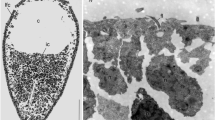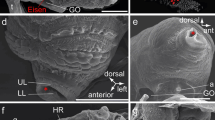Abstract
At larval and adult stage of life cycle, sponges (Porifera) have different flagellated cells that play different roles in their body. The larval epithelium cells serve as locomotion organs, while adult collar cells (choanocytes) have a feeding function. Here, for the first time, we describe detailed structure of the flagellar apparatus (kinetid) in larval cells and choanocytes of Haliclona aquaeductus and Halichondria panicea demosponges, and attach schemes of its organization, based on longitudinal and transversal ultrathin serial sections. The kinetid of larvae has proved to be more complicated than the choanocytes ones. It includes well-developed transverse and longitudinal cytoskeletons that strengthen the larval flagellum. The longitudinal skeleton in H. aquaeductus is represented by unusual structures, which were previously understudied: large tubular rootlets made of oblique-crossed fibers, which connect the kinetosome with mitochondria. We also found out that the kinetid composition varies between different cell types of a highly structured parenchymella of H. aquaeductus. In simply organized parenchymella of H. panicea, flagellated cells are identical and its kinetid includes a permanent additional centriole absent in choanocytes of adult sponges. We tried to evaluate the diversity of sponge larval kinetid organization based on literature data and found it variable within Haplosclerida and quite conservative within other sponge lineages.












Similar content being viewed by others
References
Amano S, Hori I (1992) Metamorphosis of calcareous sponges I. Ultrastructure of free-swimming larvae. Invertebr Reprod Dev 21:81–90. https://doi.org/10.1080/07924259.1992.9672223
Amano S, Hori I (1994) Metamorphosis of a demosponge I. Cells and structure of swimming larva. Invertebr Reprod Dev 25:193–204. https://doi.org/10.1080/07924259.1994.9672386
Amano S, Hori I (1996) Transdifferentiation of larval flagellated cells to choanocytes in the metamorphosis of the demosponge Haliclona permollis. Biol Bull 190:161–172
Amano S, Hori I (2001) Metamorphosis of coeloblastula performed by multipotential larval flagellated cells in the calcareous sponge Leucosolenia laxa. Biol Bull 200:20–32
Andersen RA, Barr DJS, Lynn DH et al (1991) Terminology and nomenclature of the cytoskeletal elements with the flagellar/ciliary apparatus in protists. Protoplasma 164:1–8. https://doi.org/10.1007/BF01320809
Barr DJS (2001) Chytridiomycota. In: McLaughlin DJ, McLaughlin EG, Lemke PA (eds) The Mycota VII, Part A: systematics and evolution. Springer, Berlin, pp 93–112
Blum JJ (1971) Existence of a breaking point in cilia and flagella. J Theor Biol 22:257–263
Borojevic R (1969) Étude du développement et de la différenciation cellulaire d’éponges calcaires calcinèennes (genres Clathrina et Ascandra). Ann Embryol Morph 2:15–36
Boury-Esnault N (1976) Ultrastructure de la larve parenchymella d’Hamigera hamigera (Schmidt) (Démosponge, Poecilosclerida). Origine des cellules grises. Cah Biol Mar 17:9–20
Boury-Esnault N, Ereskovsky A, Bezac C, Tokina D (2003) Larval development in the Homoscleromorpha (Porifera, Demospongiae). Invertebr Biol 122:187–202
Chakrabarti A, Schatten H, Mitchell KD et al (1998) Chloral hydrate alters the organization of the ciliary basal apparatus and cell organelles in sea urchin embryos. Cell Tissue Res 293:453–462
Ereskovsky AV (2010) The comparative embryology of sponges. Springer, London
Ereskovsky AV, Tokina DB (2004) Morphology and fine structure of the swimming larvae of Ircinia oros (Porifera, Demospongiae, Dictyoceratida). Invertebr Reprod Dev 45:137–150. https://doi.org/10.1080/07924259.2004.9652583
Ereskovsky AV, Willenz P (2008) Larval development in Guancha arnesenae (Porifera, Calcispongiae, Calcinea). Zoomorphology 127:175–187. https://doi.org/10.1007/s00435-008-0061-9
Evans CW (1977) The ultrastructure of larvae from the marine sponge Halichondria moorei Bergquist (Porifera, Demospongiae). Cah Biol Mar 13:427–433
Gallissian M-F (1983) Etude ultrastructurale du developpement embryonnaire chez Grantia compressa F. (Porifera, Calcarea). Arch Anat Microsc 72:59–75
Gallissian M-F, Vacelet J (1992) Ultrastructure of the oocyte and embryo of the calcified sponge, Petrobiona massiliana (Porifera, Calcarea). Zoomorphology 112:133–141
Gonobobleva EL (2007) Basal apparatus formation in external flagellated cells of Halisarca dujardini larvae (Demospongiae: Halisarcida) in the course of embryonic development. In: Porifera research: biodiversity, innovation and sustanability. pp 345–351
Ivanova L (1997) New data about morphology and metamorphosis of the spongillid larvae (Porifera, Spongillidae). 1. Morphology of the free-swimming larvae. Berliner geowiss Abh 20:55–71
Karpov SA (2000) Flagellate phylogeny: ultrastructural approach. In: Leadbeater BS, Green JC (eds) The flagellates: unity, diversity and evolution. Taylor and Francis, London, pp 336–360
Langenbruch PF, Jones CW (1990) Body structure of marine sponges. VI Choanocyte chamber structure in the Haplosclerida (Porifera, Demospongiae) and its relevance to the phylogenesis of the group. J Morphol 204:1–8
Lanna E, Klautau M (2012) Embryogenesis and larval ultrastructure in Paraleucilla magna (Calcarea, Calcaronea), with remarks on the epilarval trophocyte epithelium ‘placental membrane’). Zoomorphology 131:277–292. https://doi.org/10.1007/s00435-012-0160-5
Leys SP, Degnan BM (2001) Cytological basis of photoresponsive behavior in a sponge larva. Biol Bull 201:323–338
Leys SP, Degnan BM (2002) Embryogenesis and metamorphosis in a haplosclerid demosponge: gastrulation and transdifferentiation of larval ciliated cells to choanocytes. Invertebr Biol 121:171–189
Mah JL, Leys SP (2017) Think like a sponge: the genetic signal of sensory cells in sponges. Dev Biol 431:93–100. https://doi.org/10.1016/j.ydbio.2017.06.012
Maldonado M (2004) Choanoflagellates, choanocytes, and animal multicellularity. Invertebr Biol 123:1–22
Maldonado M (2006) The ecology of the sponge larva. Can J Zool 84:175–194. https://doi.org/10.1139/Z05-177
Maldonado M (2009) Embryonic development of verongid demosponges supports the independent acquisition of spongin skeletons as an alternative to the siliceous skeleton. Biol J Linn Soc 97:427–447. https://doi.org/10.1111/j.1095-8312.2009.01202.x
Maldonado M, Riesgo A (2008) Reproductive output in a Mediterranean population of the homosclerophorid Corticium candelabrum (Porifera, Demospongiae), with notes on the ultrastructure and behavior of the larva. Mar Ecol 29:298–316. https://doi.org/10.1111/j.1439-0485.2008.00244.x
Maldonado M, Durfort M, McCarthy DA, Young CM (2003) The cellular basis of photobehavior in the tufted parenchymella larva of demosponges. Mar Biol 143:427–441. https://doi.org/10.1007/s00227-003-1100-1
Moestrup Ø (1982) Flagellar structure in algae: a review, with new observations particularly on the Chrysophyceae, Phaeophyceae (Fucophyceae), Euglenophyceae, and Reckertia. Phycologia 21:427–528
Moestrup Ø (2000) The flagellate cytoskeleton: introduction of a general terminology for microtubular roots in protists. In: Leadbeater BS, Green JC (eds) The flagellates: unity, diversity and evolution. Taylor and Francis, London, pp 69–94
Morrow C, Cárdenas P (2015) Proposal for a revised classification of the Demospongiae (Porifera). Front Zool. https://doi.org/10.1186/s12983-015-0099-8
Nakanishi N, Sogabe S, Degnan BM (2014) Evolutionary origin of gastrulation: insights from sponge development. BMC Biol 12:1–9. https://doi.org/10.1186/1741-7007-12-26
Nakanishi N, Stoupin D, Degnan SM, Degnan BM (2015) Integrative and comparative biology sensory flask cells in sponge larvae regulate metamorphosis via calcium signaling. Integr Comp Biol 55:1018–1027. https://doi.org/10.1093/icb/icv014
Nielsen C (1987) Structure and function of metazoan ciliary bands and their phylogenetic significance. Acta Zool 68:205–262. https://doi.org/10.1111/j.1463-6395.1987.tb00892.x
Pozdnyakov IR, Karpov SA (2013) Flagellar apparatus structure of choanocyte in Sycon sp. and its significance for phylogeny of Porifera. Zoomorphology 132:351–357. https://doi.org/10.1007/s00435-013-0193-4
Pozdnyakov IR, Karpov SA (2015) Structure of choanocyte’s kinetid in sponge Haliclona sp. (Demospongiae, Haplosclerida) and its implication for taxonomy and phylogeny of Demospongiae. Zool Zhurnal 94:17–25. https://doi.org/10.7868/S0044513415010122
Pozdnyakov IR, Karpov SA (2016) Kinetid structure in choanocytes of sponges (Heteroscleromorpha): toward the ancestral kinetid of Demospongiae. J Morphol 277:925–934. https://doi.org/10.1002/jmor.20546
Pozdnyakov IR, Sokolova AM, Ereskovsky AV, Karpov SA (2017) Kinetid structure of choanoflagellates and choanocytes of sponges does not support their close relationship. Protistology 11:248–264. https://doi.org/10.21685/1680-0826-2017-11-4-6
Pozdnyakov IR, Sokolova AM, Ereskovsky AV, Karpov SA (2018) Kinetid structure in sponge choanocytes of Spongillida in the light of evolutionary relationships within Demospongiae. Zool J Linn Soc XX:1–18. https://doi.org/10.1093/zoolinnean/zlx109/4905843
Redmond NE, Raleigh J, Soest RWM, Van et al (2011) Phylogenetic relationships of the marine Haplosclerida (phylum Porifera) employing ribosomal (28S rRNA) and mitochondrial (cox1, nad1) gene sequence data. PLoS One 6:e24344. https://doi.org/10.1371/journal.pone.0024344
Simion P, Philippe H, Baurain D, Jager M et al (2017) A large and consistent phylogenomic dataset supports sponges as the sister group to all other animals. Curr Biol 27(7):958–967. https://doi.org/10.1016/j.cub.2017.02.031
Stephens K (2013) Insights into the evolution and development of H. indistincta (Porifera, Haplosclerida). Dissertation, National University of Ireland, Galway
Stephens KM, Ereskovsky AV, Lalor P, Mccormack GP (2013) Ultrastructure of the ciliated cells of the free-swimming larva, and sessile stages, of the marine sponge Haliclona indistincta (Demospongiae: Haplosclerida). J Exp Mar Bio Ecol 274:1263–1276. https://doi.org/10.1002/jmor.20177
Uriz MJ, Turon X, Becerro MA (2001) Morphology and ultrastructure of the swimming larvae of Crambe crambe (Demospongiae, Poecilosclerida). Invertebr Biol 120:295–307
Uriz MJ, Turon X, Mariani S (2008) Ultrastructure and dispersal potential of sponge larvae: tufted versus evenly ciliated parenchymellae. 29:280–297. https://doi.org/10.1111/j.1439-0485.2008.00229.x
Usher KM, Ereskovsky AV (2005) Larval development, ultrastructure and metamorphosis in Chondrilla australiensis Carter, 1873 (Demospongiae, Chondrosida, Chondrillidae). Invertebr Reprod Dev 47:51–62. https://doi.org/10.1080/07924259.2005.9652146
Woollacott RM (1990) Structure and swimming behavior of the larva of Halichondria melanadocia (Porifera: Demospongiae). J Morphol 205:135–145
Woollacott RM (1993) Structure and swimming behavior of the larva of Haliclona tubifera (Porifera: Demospongiae). J Morphol 218:301–321
Woollacott RM, Pinto RL (1995) Flagellar basal apparatus and its utility in phylogenetic analyses of the Porifera. J Morphol 226:247–265
Yubuki N, Leander BS (2013) Evolution of microtubule organizing centers across the tree of eukaryotes. Plant J 75:230–244
Acknowledgements
The research was supported by the Russian Foundation for Basic Research (projects nos. 17-304-50015 and 18-04-01314). We thank Research Resource Center for Microscopy at Zoological Institute of Russian Academy of Sciences and Research Resource Center for Molecular and Cell Technologies (RRC MCT) at St. Petersburg State University for access to the EM facilities. We are also grateful to A. B. Tsetlin and personnel of White Sea Biological station (WSBS MSU) for assistance.
Author information
Authors and Affiliations
Corresponding author
Ethics declarations
Conflict of interest
The authors declare that they have no conflict of interest.
Ethical approval
We neither used endangered species nor were the investigated animals collected in protected areas. All applicable international, national, and/or institutional guidelines for the care and use of animals were followed. This article does not contain any studies with human participants performed by any of the authors.
Informed consent
Informed consent was obtained from all the individual participants included in the study.
Additional information
Publisher’s Note
Springer Nature remains neutral with regard to jurisdictional claims in published maps and institutional affiliations.
Rights and permissions
About this article
Cite this article
Sokolova, A.M., Pozdnyakov, I.R., Ereskovsky, A.V. et al. Kinetid structure in larval and adult stages of the demosponges Haliclona aquaeductus (Haplosclerida) and Halichondria panicea (Suberitida). Zoomorphology 138, 171–184 (2019). https://doi.org/10.1007/s00435-019-00437-5
Received:
Revised:
Accepted:
Published:
Issue Date:
DOI: https://doi.org/10.1007/s00435-019-00437-5




